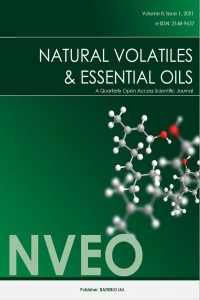Abstract
References
- Barkin, R. L. (2013). The pharmacology of topical analgesics. Postgraduate Medicine, 125(sup1), 7-18.
- Chandrakanthan, M., Handunnetti, S. M., Premakumara, G. S. A. and Kathirgamanathar, S. (2020). Topical anti-Inflammatory activity of essential oils of Alpinia calcarata Rosc., its main constituents, and possible mechanism of action. Evidence-Based Complementary and Alternative Medicine, Article ID 2035671, 19 pages
- Clinical and Laboratory Standards Institute M7-A7, 2006. Methods for Dilution Antimicrobial Susceptibility Tests for Bacteria That Grow Aerobically; Approved Standard-Seventh Edition, CLSI document A. Wayne, Pa. USA. 26(2).
- Hendry, E. R., Worthington, T., Conway, B. R., & Lambert, P. A. (2009). Antimicrobial efficacy of eucalyptus oil and 1, 8-cineole alone and in combination with chlorhexidine digluconate against microorganisms grown in planktonic and biofilm cultures. Journal of Antimicrobial Chemotherapy, 64(6), 1219-1225.
- Jirovetz, L., Buchbauer, G., Denkova, Z., Stoyanova, A., Murgov, I., Schmidt, E., & Geissler, M. (2005). Antimicrobial testinas and gas chromatoaraphic analysis of pure oxyaenated monoterpenes 1.8-cineole, α-terpineol, terpinen-4-ol and camphor as well as target comoounds in essential oils of pine (Pinus pinaster), rosemary (Rosmarinus officinalis), tea tree (Melaleuca alternifolia). Scientia Pharmaceutica, 73(1), 27-39.
- Kifer, D., Mužinić, V., & Klarić, M. Š. (2016). Antimicrobial potency of single and combined mupirocin and monoterpenes, thymol, menthol and 1, 8-cineole against Staphylococcus aureus planktonic and biofilm growth. The Journal of Antibiotics, 69(9), 689-696.
- Lenardão, E. J. Savegnago, L., Jacob, R. G., Victoria, F. N. and Martinez, D. M. (2016). Antinociceptive effect of essential oils and their constituents: an update review. Journal of the Brazilian Chemical Society, 27(3), 435-474.
- McLafferty, F.W., Stauffer D.B. (1989). The Wiley/NBS Registry of Mass Spectral Data, J Wiley and Sons: New York. Santos, F.A. and Rao, V.S.N. (2000). Antiinflammatory and antinociceptive effects of 1,8-Cineole a terpenoid oxide present in many plant essential oils. Phytotherapy Research, 14, 240–244.
- Vuuren, S. V., & Viljoen, A. M. (2007). Antimicrobial activity of limonene enantiomers and 1, 8‐cineole alone and in combination. Flavour and Fragrance Journal, 22(6), 540-544.
- Zakharova, E.A., Kljuykov, E.V., Degtjareva, G.V., Samigullin, T., Ukrainskaya, U.A., & Downie, S.R. (2016). A taxonomic study of the genus Hellenocarum H. Wolff (Umbelliferae-Apioideae) based on morphology, fruit anatomy, and molecular data. Turkish Journal of Botany, 40(2), 176-193.
Volatile components and antimicrobial activity of the n-hexane extracts of Neomuretia pisidica (Kit Tan) Kljuykov, Degtjareva & Zakharova
Abstract
The fruits, aerial parts and roots of Neomuretia pisidica (Kit Tan) Kljuykov, Degtjareva & Zakharova were extracted with n-hexane. Total of 18 compounds were characterised by GC analyses of the n-hexane extracts. Main volatile components of the n-hexane extract of aerial parts were characterized as 1,8-cineole (23.4 %), camphor (21.4 %), 2-ethyl hexanol (14.6 %), α-pinene (7.2 %), and verbenone (6.4 %). Methyl linoleate (19.3 %), 1,8-cineole (16.5 %), camphor (13.2 %), α-pinene (6.1 %) and 2-ethyl hexanol (4.9 %) were found in the n-hexane extract of roots. Whereas, 1,8-cineole (23.3 %), camphor (20.3 %), 2-ethyl hexanol (14.2 %), α-pinene (9.9 %), and limonene (4.1%) were the major components of the n-hexane extract of fruits. Antimicrobial activity were identified using a microdilution assay against selected human pathogenic strains. The most potent inhibitor activities with 156 µg/mL concentrations were detected against S. aureus and E. faecalis.
References
- Barkin, R. L. (2013). The pharmacology of topical analgesics. Postgraduate Medicine, 125(sup1), 7-18.
- Chandrakanthan, M., Handunnetti, S. M., Premakumara, G. S. A. and Kathirgamanathar, S. (2020). Topical anti-Inflammatory activity of essential oils of Alpinia calcarata Rosc., its main constituents, and possible mechanism of action. Evidence-Based Complementary and Alternative Medicine, Article ID 2035671, 19 pages
- Clinical and Laboratory Standards Institute M7-A7, 2006. Methods for Dilution Antimicrobial Susceptibility Tests for Bacteria That Grow Aerobically; Approved Standard-Seventh Edition, CLSI document A. Wayne, Pa. USA. 26(2).
- Hendry, E. R., Worthington, T., Conway, B. R., & Lambert, P. A. (2009). Antimicrobial efficacy of eucalyptus oil and 1, 8-cineole alone and in combination with chlorhexidine digluconate against microorganisms grown in planktonic and biofilm cultures. Journal of Antimicrobial Chemotherapy, 64(6), 1219-1225.
- Jirovetz, L., Buchbauer, G., Denkova, Z., Stoyanova, A., Murgov, I., Schmidt, E., & Geissler, M. (2005). Antimicrobial testinas and gas chromatoaraphic analysis of pure oxyaenated monoterpenes 1.8-cineole, α-terpineol, terpinen-4-ol and camphor as well as target comoounds in essential oils of pine (Pinus pinaster), rosemary (Rosmarinus officinalis), tea tree (Melaleuca alternifolia). Scientia Pharmaceutica, 73(1), 27-39.
- Kifer, D., Mužinić, V., & Klarić, M. Š. (2016). Antimicrobial potency of single and combined mupirocin and monoterpenes, thymol, menthol and 1, 8-cineole against Staphylococcus aureus planktonic and biofilm growth. The Journal of Antibiotics, 69(9), 689-696.
- Lenardão, E. J. Savegnago, L., Jacob, R. G., Victoria, F. N. and Martinez, D. M. (2016). Antinociceptive effect of essential oils and their constituents: an update review. Journal of the Brazilian Chemical Society, 27(3), 435-474.
- McLafferty, F.W., Stauffer D.B. (1989). The Wiley/NBS Registry of Mass Spectral Data, J Wiley and Sons: New York. Santos, F.A. and Rao, V.S.N. (2000). Antiinflammatory and antinociceptive effects of 1,8-Cineole a terpenoid oxide present in many plant essential oils. Phytotherapy Research, 14, 240–244.
- Vuuren, S. V., & Viljoen, A. M. (2007). Antimicrobial activity of limonene enantiomers and 1, 8‐cineole alone and in combination. Flavour and Fragrance Journal, 22(6), 540-544.
- Zakharova, E.A., Kljuykov, E.V., Degtjareva, G.V., Samigullin, T., Ukrainskaya, U.A., & Downie, S.R. (2016). A taxonomic study of the genus Hellenocarum H. Wolff (Umbelliferae-Apioideae) based on morphology, fruit anatomy, and molecular data. Turkish Journal of Botany, 40(2), 176-193.
Details
| Primary Language | English |
|---|---|
| Subjects | Health Care Administration |
| Journal Section | Articles |
| Authors | |
| Publication Date | March 31, 2021 |
| Published in Issue | Year 2021 Volume: 8 Issue: 1 |


